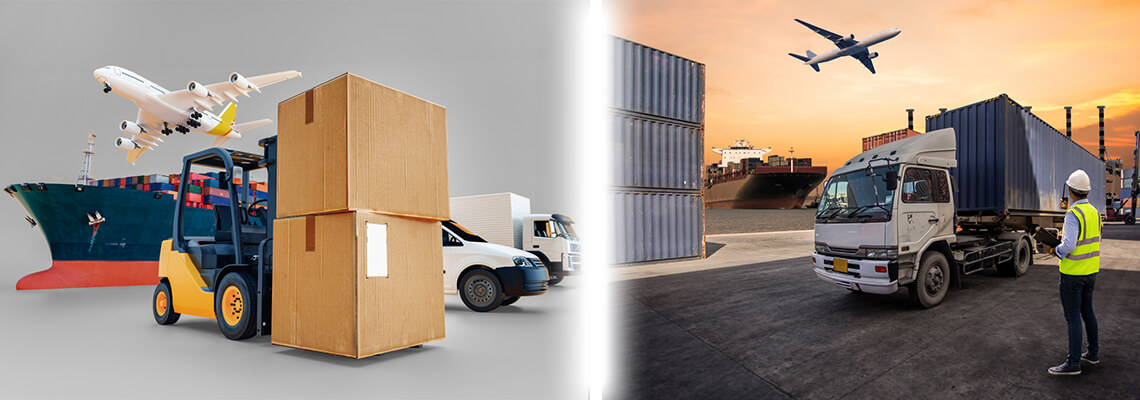 25 Jul 2025
25 Jul 2025
Major Differences between Transport and Logistics
When people hear logistics transport, they often imagine trucks carrying goods from one place to another. But logistics transportation is much more than just moving things. It includes planning, organising, and making sure goods reach the right place at the right time.
Transport and logistics work together, but they have different roles. Transport moves goods, while logistics manages everything from storage to delivery. Let’s explore what is transport and logistics and how they are different.
What is Transport and Logistics?
Transport and logistics are both important in delivering goods from manufacturers to customers. But what do these words really mean?
What is Transportation?
Transportation is all about moving goods from one place to another. It includes different ways of travel, such as:
- Road – Trucks and vans deliver goods on highways and streets
- Air – Airplanes fly important packages across long distances
- Sea – Ships carry big containers across oceans
- Rail – Trains transport heavy loads over long distances
When companies prepare cargo, they think about how much it costs, how fast it needs to get there, and how large or heavy the items are.
What is Logistics?
Logistics is the brain behind transportation. It makes sure goods move smoothly from where they are made to where they are needed. Logistics includes:
- Planning routes – Choosing the best way to send goods
- Storing products – Keeping items safe before delivery
- Tracking shipments – Following packages as they travel
- Managing inventory – Keeping the right number of products in stock
Without logistics companies, transportation wouldn’t work well. Logistics ensures everything arrives on time and in perfect shape.
Difference Between Logistics and Transportation
Though transport and logistics work together, they are not the same. Here’s how they differ:
1. Transportation Moves, Logistics Manages
Transportation is the physical movement of goods. Logistics is the planning behind it. Logistics decides the best way to store, package, and deliver goods safely.
2. Logistics Organizes, Transportation Delivers
Logistics takes care of organizing, packing, and handling goods before sending them out. Transportation ensures the items reach their final destination.
3. Logistics Solves Problems, Transportation Follows Routes
Logistics managers solve problems like delays, damaged goods, and customs rules. Transport drivers or pilots follow the routes set by logistics teams.
4. Transportation Uses Vehicles, Logistics Uses Strategies
Transportation involves trucks, planes, ships, and trains. Logistics includes planning, tracking, and decision-making to ensure smooth delivery.
5. Logistics Handles More Than Just Transportation
Logistics covers inventory, storage, supply chain management, and customer service. Transportation only focuses on moving goods.
By understanding the logistics and transportation differences, businesses can improve their supply chain operations.
How Transport and Logistics Work Together
Technology is making logistics transportation quicker and smarter. Here’s how:
- A product is ready to ship – Logistics decides the best way to send it
- Goods are packed and stored – Logistics ensures they are safe and ready for transport
- Transportation takes over – Trucks, ships, or planes move the goods
- Tracking and updates – Logistics teams monitor shipments to prevent delays
- Delivery to customers – Logistics ensures products reach the right place on time
Why Are Logistics and Transportation Important?
Both transport and logistics are essential for businesses. Without them, products wouldn’t reach customers on time. Here’s why they matter:
1. Faster Delivery
Logistics ensures goods move quickly and smoothly. Transportation makes sure they reach the right location.
2. Cost Savings
Good logistics planning reduces waste and saves money. Choosing the right transport method keeps delivery costs low.
3. Better Customer Satisfaction
When businesses deliver on time, customers are happy. Logistics makes sure orders arrive correctly, and transportation ensures they get there fast.
4. Efficient Supply Chain
Logistics connects manufacturers, suppliers, and customers. Transportation moves products between them. Together, they keep businesses running.
Challenges in Logistics and Transportation
Even though logistics and transportation work well, they still face challenges.
1. Traffic and Delays
Bad weather, roadblocks and traffic jams can slow down transportation. Logistics teams find alternate routes to avoid delays.
2. High Costs
Fuel prices, maintenance, and labour costs make transportation expensive. Logistics teams find ways to cut costs while ensuring smooth delivery.
3. Customs and Regulations
Import and export rules can slow shipments. Logistics teams handle paperwork to prevent delays.
4. Damage and Loss
Goods can get lost or damaged in transit. Logistics ensures safe packaging, and transportation takes care of careful handling.
How Technology is Changing Transport and Logistics
Technology is making logistics transport quicker and smarter. How:
1. GPS Tracking
Companies utilize GPS to monitor shipments in real-time. This helps them control delays and reroute deliveries in case necessary.
2. Automated Warehouses
Robots and machines help store and sort products. This can make logistics faster and reduces human mistakes.
3. Drones and Electric
Vehicles Some businesses deliver using electric trucks and drones. They’re quicker and more advantageous for the environment.
4. Artificial Intelligence (AI) in Logistics
AI helps anticipate demand, manage inventory, and locate the best shipping routes.
Final Thoughts on Transport as well as Logistics
Transport and logistics collaborate to ensure that products reach their destinations safely and on time. Logistics is tasked with controlling storage, tracking and delivery preparation while transportation moves products.
Understanding the difference between logistics and transportation helps companies enhance their supply chain and serve customers better. Logistics transport is continually becoming quicker and more efficient through smart strategies and new technologies.
